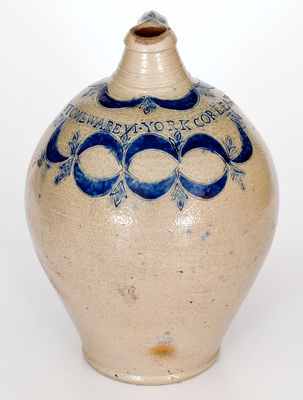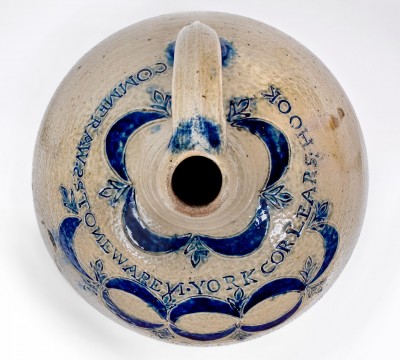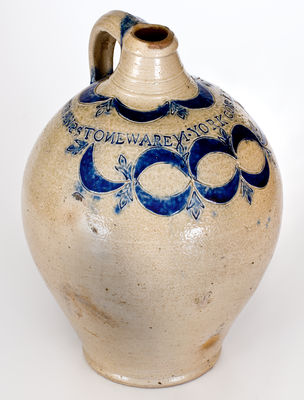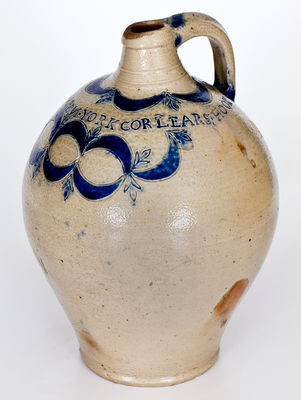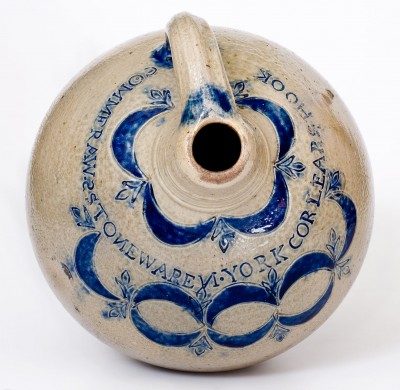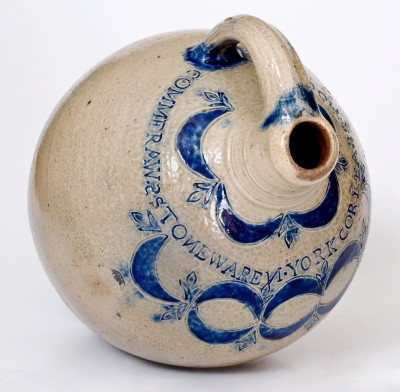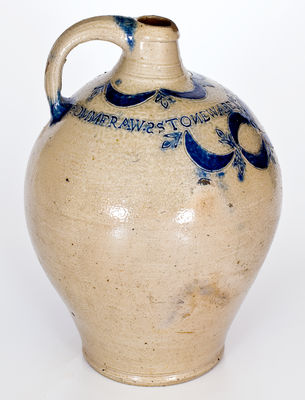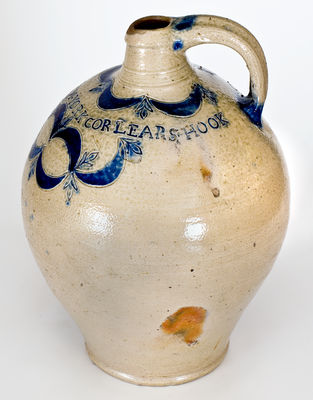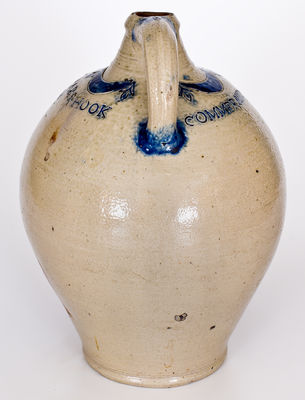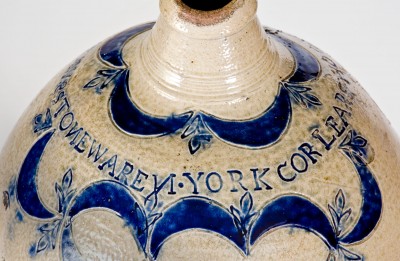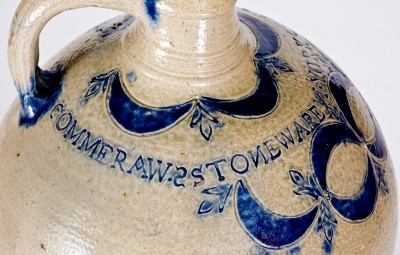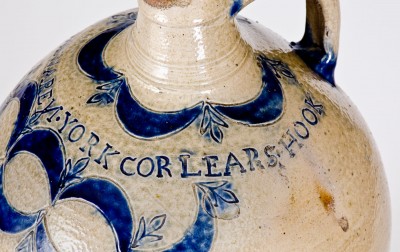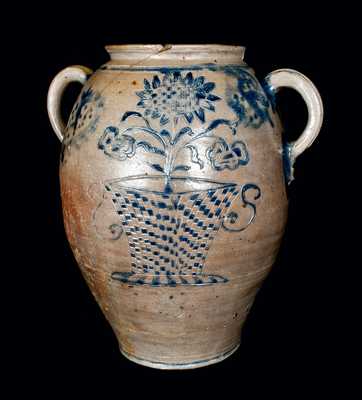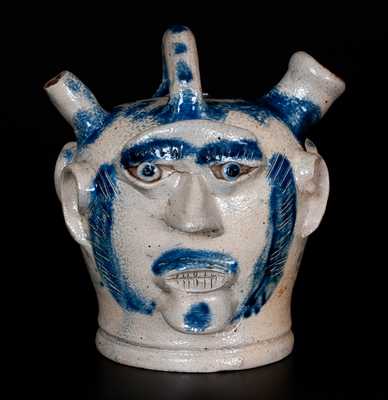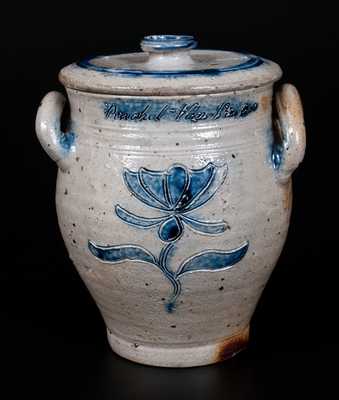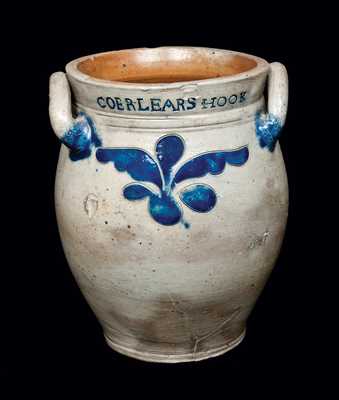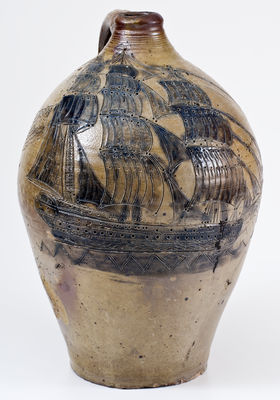Exceptional Three-Gallon Stoneware Jug with Elaborate Impressed Drape-and-Tassel Motif, Stamped "COMMERAWS STONEWARE N. YORK CORLEARS HOOK," Thomas Commeraw, Manhattan, NY, late 18th or early 19th century, bulbous jug with footed base, tapered spout with tooled banding, and semi-rounded mouth, decorated throughout with impressed and cobalt-highlighted drape-and-tassel motifs. Four such designs, popular during the Federal period in American decorative arts, form a band around the jug's shoulder. Additional drape-and-tassel designs appear below, each inverted as a mirror image upon themselves, producing what collectors and historians refer to as a "clamshell" design (perhaps more accurately, a bowknot), a stoneware motif probably created by Commeraw and occasionally copied in an impressed or incised form by a few of his contemporaries. Three such clamshell designs adorn the front, identifying the jug as three gallons in capacity. Two diagonally-oriented, drape-and-tassel motifs connect these designs to the impressed maker's mark, "COMMERAWS STONEWARE N. YORK CORLEARS HOOK," appearing in a single line. Cobalt highlights appear within the stamped text and surround the handle terminals.
The combination of several traits of this jug define it as Commeraw's masterwork. The stamped decoration is unusually extravagant. While most Commeraw pieces feature only clamshell motifs or a single group of drapes and tassels, this work displays both. The inclusion of diagonal drape-and-tassel designs connecting the clamshell motifs to the maker's mark is also highly unusual. The jug features Commeraw's most elaborate maker's mark in an extremely rare single-line orientation, impressed as continuous text around the shoulder. When found, this maker's mark is typically seen impressed in five lines down the vessel's front. The potting of the jug is also exemplary, more ovoid and therefore somewhat more difficult to make than typical jugs from this maker or period. Highly ovoid forms remained uncommon in American stoneware production for another twenty years. This jug's shape runs contrary to that, pairing a dramatically-swelled body with a narrow base and a stop below its spout. The jug's dramatically swelled shape showcases Commeraw's ability as a potter, while also appearing intentionally designed to accommodate its dramatic stamped treatments.
Perhaps most instantly recognizable about the jug is its color. This jug survives as one of the most beautifully-colored examples of signed Manhattan stoneware known, both in its clay and vivid cobalt-slip decoration. It is the result of the selection of finely-milled clay, proper concoction of the cobalt slip, and an exacting firing, involving good placement in the kiln and the correct amount of salt. The appearance speaks to Commeraw's abilities not just as a potter, but as a producer of ware, a chemist in clay. While a large body of signed work of more well-known Manhattan potters, Clarkson Crolius, Sr. and John Remmey III, has survived, none feature the refined color and glazing of this example. The jug seems to proudly state that this potter, not of the long lineage of European-born Crolius and Remmey potters, was producing a superior product.
More than a skilled stoneware manufacturer, Thomas Commeraw was also the first African-American pottery owner and one of the nation's earliest documented artisans of African descent to operate his own business and sign his ware. An abolitionist and civil rights activist in federal-era New York City, in 1820 Commeraw traveled to the west coast of Africa to help plant a repository for Africans rescued off of slave ships. This jug's outstanding color, stamping, and form suggest it may have served to distinguish the potter as a leading producer of stoneware in Manhattan, possibly displayed as a storefront piece. The artistry of this work rank it among the most important examples of African-American utilitarian art known.
This jug survives in excellent, as-made condition with only a few very minor, in-the-firing surface flaws, typical of early-period stoneware. The remarkable condition of this jug, at around 220 years of age, is noteworthy, as most examples of early Manhattan stoneware are found with damage of some sort. Its sublime condition may support the theory that this jug was made as a display piece. H 15".

